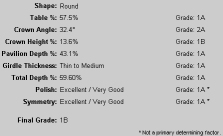- Joined
- Aug 4, 2008
- Messages
- 15,735
Hi Paul,Date: 3/11/2010 10:51:13 AM
Author: Paul-Antwerp
This is frustrating.
RD is putting me on trial (kind-of), because he disagrees with my statement:
''GIA''s and AGS''s cut-grade, ASET, IS and HCA are indeed valid techniques, some of them vetted by science, to judge potential brightness most often of a round brilliant only.''
Now, after a lot of word-twisting, everybody is giving opinions aside from the original topic.
Question: If going back to my original question, can anybody disagree? If not, can we agree that this is an undisputable basis?
Live long,
I agree with your statement as far as it goes.
I have been staying out of this thread because I refuse to discuss it in this context, it is not fair.







300x240.png)